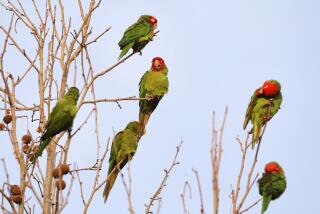Bird Watching
We surprised a flock of a dozen cedar waxwings (Bombycilla cedrorum) sampling pyracantha and Toyon berries as we made our way to the bus one recent morning. We have a particular affection for them because they are one of the few birds that we have learned to identify. In their case, that isn’t difficult because of their elegant crests.
They will probably be around for another month, gleaning berries from shrubs and trees and starting the transition to their warm-weather diet of insects, we learned from Kimball L. Garrett, collection manager in the ornithology section of the Los Angeles County Museum of Natural History.
Cedar waxwings are notable nomads--traveling in large flocks, erratic in their itineraries and schedules, apparently guided by what they find to satisfy their appetites, Garrett told us. They are in Southern California this year in numbers above the average, by his calculations. In some years there are very few. They nest and summer all across the Northern forests of the United States, from Northern California to Maine, and in the forests of Canada as well. They winter in all of the Southern states, showing special appreciation for the berries of many California native plants.
Robert Middlekauff, a committed bird watcher who also is director of the Huntington Library, Art Collections and Botanical Gardens in San Marino, confirmed the significant turnout of cedar waxwings this year. He has spotted flocks of as many as 30 in the Huntington Gardens.
His bird-watching enthusiasm was converted on Feb. 22 into the establishment of the Huntington Bird Society. Its 90 volunteers are now making a computerized census of birds in the Huntington Gardens. The census ultimately will be translated into a bird watchers’ guide for visitors who want a diversion from Gainsborough, the Gutenberg Bible or the Shakespeare Garden. In the first month the volunteers counted 49 species.
Cedar waxwings should not be confused with their more exotic-looking cousin, the Bohemian waxwing--but there is not much risk of that, because the Bohemians rarely venture this far south.
Incidentally, the birds don’t have wax on their wings. It just looks like they do. Garrett explained that the flecks of red visible near the wing tips are not sealing wax but a curious part of the wing-feather structure. The birds are more readily identified by their black masks, by the bright yellow band at the tip of the tail, by the yellow tones of the belly and, of course, by those crests.
More to Read
Sign up for The Wild
We’ll help you find the best places to hike, bike and run, as well as the perfect silent spots for meditation and yoga.
You may occasionally receive promotional content from the Los Angeles Times.






